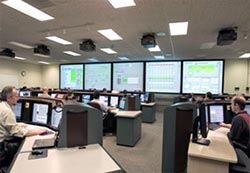Integrated Computer Control System
 The NIF control room. The shot director's desk is on the left. View video.Aligning and timing NIF's 192 giant laser beams to simultaneously hit a target the size of a pea is roughly like hitting the strike zone with a baseball from 350 miles away.The linchpin that makes NIF operations and experiments possible is the facility's integrated computer control system (ICCS), among the most complex automated control systems ever designed for a scientific machine.
The NIF control room. The shot director's desk is on the left. View video.Aligning and timing NIF's 192 giant laser beams to simultaneously hit a target the size of a pea is roughly like hitting the strike zone with a baseball from 350 miles away.The linchpin that makes NIF operations and experiments possible is the facility's integrated computer control system (ICCS), among the most complex automated control systems ever designed for a scientific machine.
With about two million lines of code running on more than 850 computers, ICCS will ensure that all of NIF's 192 laser beams arrive at the target within a few tens of picoseconds of each other and that a host of diagnostic instruments record data in a few billionths of a second. A team of about 100 software developers, engineers, and quality control experts designed a flexible solution for a complex system whose pieces operate individually but, at the time directed, work in unison.
The NIF control system uses an innovative architecture that allows 24 bundles of eight laser beams to be aligned and prepared for a shot independently (View Video). With this modular approach, scientists can design experiments so that individual bundles have different energy and waveform characteristics. Operated from a main control room, ICCS fires the laser and conducts these experiments automatically. In response to a command from the shot director, ICCS software directs the actions of hundreds of computers controlling NIF through a complex script that calculates the required configuration of the laser beams, aligns them on target, fires the laser, and collects the data. NIF is thus an unusually flexible user facility that will provide scientists with the wide experimental regime they need in the decades ahead.
The NIF control room is inspired by the National Aeronautics and Space Administration's mission control room in Houston, Texas. Control room operators access data through a hierarchy of on-screen graphics menus. The data shown correspond to some 60,000 control points for electronic, optical, and mechanical devices, such as motorized mirrors and lenses, energy and power sensors, video cameras, laser amplifiers, and diagnostic instruments. Operators can also view videos of the laser beams and target from camera sensors incorporated into the beam path and target chamber.
 Electronics engineer Judy Liebman analyzes a video of a NIF laser beam produced by one of the ICCS's 300 high-resolution cameras.Twenty-four hours a day, the system supervises shot setup and countdown; oversees machine interlocks to protect hardware, data, and personnel; generates reports on system performance; provides operators with graphical interfaces for control and system status displays; performs beam alignment; diagnoses and controls power conditioning and electro-optic subsystems; and monitors the health of all subsystems and components.
Electronics engineer Judy Liebman analyzes a video of a NIF laser beam produced by one of the ICCS's 300 high-resolution cameras.Twenty-four hours a day, the system supervises shot setup and countdown; oversees machine interlocks to protect hardware, data, and personnel; generates reports on system performance; provides operators with graphical interfaces for control and system status displays; performs beam alignment; diagnoses and controls power conditioning and electro-optic subsystems; and monitors the health of all subsystems and components.
ICCS demonstrated its effectiveness during the 18-month experimental campaign called NIF Early Light, which was completed in October 2004. This campaign used the first four laser beams to conduct more than 400 shots. It validated the modular architecture while performing unique experiments in high energy density physics supporting stockpile stewardship. In December 2006, NIF's first "cluster" of six bundles became operationally qualified when all 48 beams in the cluster were fired simultaneously. ICCS was able to fire the entire shot cycle, including alignment, shot setup, data archiving, shot data analysis and post-shot amplifier cooling, in a little more than three hours. Then in August of 2007, ICCS fired the first two clusters, or 96 beams, completing the operational qualification of NIF's Laser Bay 2 and establishing a world record for infrared laser energy at more than 2.1 megajoules.
All subsystems participated in the shots to test NIF's end-to-end functionality. At least one of every type of hardware device was successfully monitored and controlled by ICCS. Among its many accomplishments, the control system demonstrated that it can use deformable mirrors to maintain the optical quality in laser beams (see Optics), synchronize the beams' arrival at their targets and align the laser's optical elements to ensure that the beams hit their targets precisely.
More Information
"From Data to Discovery," Science & Technology Review, January/February 2011
"Automated Technology for Laser Fusion Systems," Science & Technology Review, November 2008
"Orchestrating the World's Most Powerful Laser," Science & Technology Review, July/August 2005.
"Controlling the World's Most Powerful Laser," Science & Technology Review, November 1998




